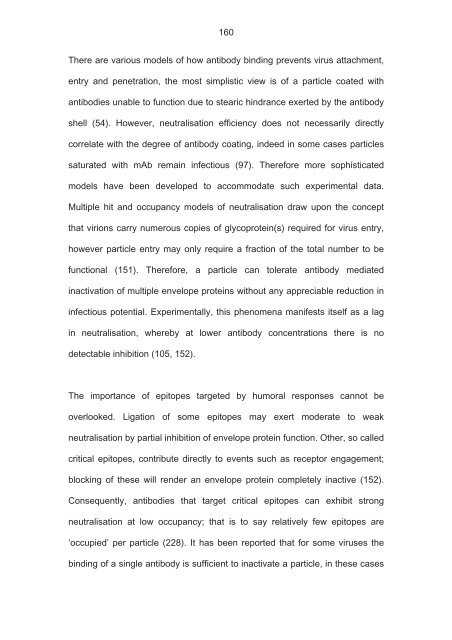The role of scavenger receptor BI in hepatitis - eTheses Repository ...
The role of scavenger receptor BI in hepatitis - eTheses Repository ...
The role of scavenger receptor BI in hepatitis - eTheses Repository ...
You also want an ePaper? Increase the reach of your titles
YUMPU automatically turns print PDFs into web optimized ePapers that Google loves.
160<br />
<strong>The</strong>re are various models <strong>of</strong> how antibody b<strong>in</strong>d<strong>in</strong>g prevents virus attachment,<br />
entry and penetration, the most simplistic view is <strong>of</strong> a particle coated with<br />
antibodies unable to function due to stearic h<strong>in</strong>drance exerted by the antibody<br />
shell (54). However, neutralisation efficiency does not necessarily directly<br />
correlate with the degree <strong>of</strong> antibody coat<strong>in</strong>g, <strong>in</strong>deed <strong>in</strong> some cases particles<br />
saturated with mAb rema<strong>in</strong> <strong>in</strong>fectious (97). <strong>The</strong>refore more sophisticated<br />
models have been developed to accommodate such experimental data.<br />
Multiple hit and occupancy models <strong>of</strong> neutralisation draw upon the concept<br />
that virions carry numerous copies <strong>of</strong> glycoprote<strong>in</strong>(s) required for virus entry,<br />
however particle entry may only require a fraction <strong>of</strong> the total number to be<br />
functional (151). <strong>The</strong>refore, a particle can tolerate antibody mediated<br />
<strong>in</strong>activation <strong>of</strong> multiple envelope prote<strong>in</strong>s without any appreciable reduction <strong>in</strong><br />
<strong>in</strong>fectious potential. Experimentally, this phenomena manifests itself as a lag<br />
<strong>in</strong> neutralisation, whereby at lower antibody concentrations there is no<br />
detectable <strong>in</strong>hibition (105, 152).<br />
<strong>The</strong> importance <strong>of</strong> epitopes targeted by humoral responses cannot be<br />
overlooked. Ligation <strong>of</strong> some epitopes may exert moderate to weak<br />
neutralisation by partial <strong>in</strong>hibition <strong>of</strong> envelope prote<strong>in</strong> function. Other, so called<br />
critical epitopes, contribute directly to events such as <strong>receptor</strong> engagement;<br />
block<strong>in</strong>g <strong>of</strong> these will render an envelope prote<strong>in</strong> completely <strong>in</strong>active (152).<br />
Consequently, antibodies that target critical epitopes can exhibit strong<br />
neutralisation at low occupancy; that is to say relatively few epitopes are<br />
‘occupied’ per particle (228). It has been reported that for some viruses the<br />
b<strong>in</strong>d<strong>in</strong>g <strong>of</strong> a s<strong>in</strong>gle antibody is sufficient to <strong>in</strong>activate a particle, <strong>in</strong> these cases

















